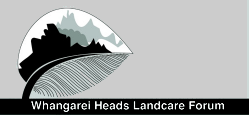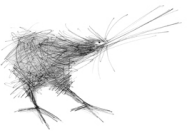22 – May Report
Whangarei Heads Landcare Forum AGM
Wednesday June 29, 7.30pm, McLeod Bay Hall
Thank you for your patience waiting for the date
Please come along to the bigger, flasher McLeod Bay hall and invite any other interested locals – we will have plenty of room to spread out. WHLF is a crucial platform for the many Landcare groups and individuals at the Whangarei Heads and it enables much of the positive work being done to happen. It would be great if a representative of each local group could please give a brief update of what their group has been up to this year. It is always interesting and heartening to hear what all the different groups are doing to make the Heads a better place.
Please put the date on your calendar, hope that you can make it.
Kiwi Counting
Our annual kiwi count is well under way with keen counters at most of our 20 sites throughout the Heads counting kiwi calls and working out approximate kiwi locations. We did get a good week of calm weather but the wind, rain and surf noise (and busy lives) are making things tricky for those trying to finish their 4 nights counting. The first listening window finishes on June 8, the backup window (which usually has fewer calls as the dads are often nesting by then) is June 17 to July 7. THANK YOU to all our hard working counters and data collectors. It has been great to have some more young keen ears join this year with 5 of the Predator Free Whangarei team helping out. See pic of Joanne tucked up warm counting away. Also see photo from one of the PFW trail cameras of a kiwi calling to the camera. To date the kiwi counts have been good, once the data is in Fay and I will process it and let you know what is happening to your kiwi population.
Kiwi Coast 2022 Northland Pest Control Zui
This was an extremely well run event – Thank you to Ngaire and her Kiwi Coast team. Informative and interesting topics covered included new pest control technology, such as a new ferret trap from master trap maker Steve Allan. Great to hear of other groups using controlled ground based 1080 pulses to control trap shy stoats with good results. If you missed it a recording of the sessions will be up on the Kiwi Coast website – I will let you know when it is there.
Backyard Kiwi Predator Control Program:
Plenty of weasels in the traps. Stoats predate the smaller weasels so this is hopefully an indicator of lower stoat numbers but remember there are still stoats out there avoiding traps!
May catches: Stoats 1, Weasels 9, Cat 3, Rats 105, Hedgehogs 9, Possums 11.
If you are doing rat control at your place this is a good time to give them a toxin pulse as the weather gets colder, it is a double whack on rat numbers and it makes it easier to keep them down for the spring.
What your kiwi have been up to:
The ongoing wet conditions are perfect feeding conditions for kiwi. The kiwi are in great condition for breeding and kiwi calling should start to drop off as the mums do the amazing feat of developing and laying 2 large eggs and the dads begin their long 3 month incubation.
One potential dad that we have been following since his release at Parua Bay in 2018 is Ross. This guy starred in our very popular “The Kiwi Release” video (see it in the video section of our website) and he became a pioneer kiwi for us as he struck out westward to eventually settle at Pepi Road near the golf course. His radio transmitter was due for changing in May but the attachment band worn through and the transmitter dropped off, so we are unlikely to know the details of his future. He is settled in a safe dog free area. His one time boyfriend Pepi will have to carry the monitoring batten now – you never know I might find them tucked up together again. Kia kaha Ross – see pic of him at release and see his full story
Whangarei Heads/Parua Bay Radio monitored kiwi:
- Chookie– Usual area of pines and natives SW end of Martins’ Owhiwa Road block. 12 hours activity. He should be feeding up for nesting.
- Malaika– In her now usual area of pampas, in the young pine block, not far from Chookie. 7.5 hours average nightly activity with nights as low as 6.5 hours – she may be gravid (developing eggs for laying).
- Valentine – Finally found her, tucked up in a valley at the back of Martins’ block towards Tauranui Road. She is still moving around a lot. Did her transmitter change ; she was in good condition, 2500g, and 136.4 mm bill length (cf 131.4 mm back in 30/8/21) so she is still growing. Her activity was 11 hours. When I checked her signal 6 days later her new tx was in mortality mode – but she had moved 500m and was well away from any dogs so I left her another day and she had moved another 500m! So she is definitely not dead or dropped her transmitter, for some reason the tx has gone into mort mode and now is latched in that. The upside is the 80 pulses (compared to the usual 30) makes her signal way easier to find so I will leave that tx on until she settles down. Hopefully her recent wanderings are in a bid to find a mate now that she is nearly fully grown.
- Teina – He moved out of the dense pampas into the nearby native for a few days so I took the opportunity to catch up with him. He was in a deep burrow – did tx change; a fat 3025g- extremely heavy for a male, he really needs a nesting stint to trim him down. 12 hours nightly average.
- Beach Girl – She is still in the native bush on Halses’ block off Ross Road. Not far from Teina.
- Ross– His tx was due to be changed this month but he dropped it. A bit of a bugger as Ross is the furthest West that we have had any monitored kiwi go and he is keenly followed by locals. After being released in 2018 and starring in videos and other kiwi storytelling as he travelled westward, it is a shame we couldn’t follow through with him to breeding (although cuddling up with male kiwi like Pepi wasn’t going to produce any eggs!). He did lead us to Pepi who can now carry the monitored batten in that area.
- Pepi– in the pampas just west of Pepi road, a few 100m from where Ross dropped his tx. 11.5 hours nightly activity.
- Wally – Wally is still down by the estuary edge at the end of Campbell road and has a nightly activity of 11 hours.
- Pakipaki– After spending time last month in the pampas below the Manaia club she has returned to her pampas patch in the McLeod Bay Horse Paddock. Couldn’t find her for a while as her tx signal had drifted up a channel. 10.5 hours activity.
Rarewarewa/Purua – These are the dads that we monitor to transfer chicks from to Matakohe/Limestone Island. FOMLI Ranger Jo Skyme gave me a hand to do some transmitter changes
- Nick – Jo helped me with his tx change. He was in the same flax and kikuya by Lovells’ quarry pond that he was in last May. 10 hours of nightly activity (see pic).
- Sancho–His data stream kept showing nesting mode and low activity ( 70 min!) but he was definitely not nesting – I checked him 3 times in 3 different places. Eventually caught up with him in a shallow burrow in the paddock north of the quarry. No sign of nesting and in a healthy condition. Changed his tx, he was 2100g. His new tx data stream showed 14.5 hours activity a week later so the old one definitely had a sticky mercury switch or some other fault.
- Ngutu Roa – Jo and I caught up with him in a shallow burrow just west of the big slip in the reserve for his tx change, 2250g , Good condition, 12 hours activity.
- Moondust– This guy has proved to be particularly hard to catch up with in the deep guts in the reserve behind the woolshed. Got him in the raupo/paratanewha area on the reserve fence line for his tx change. 2350g and good condition. 11 hours activity.
- Gorgeous – Usual area Hawkins’ hill. 11 hours activity.
- Nanakia– In Lovells’ bush/ pine slash area. Average activity is back up to 11.5 hours after dipping to 9 hours last month.
The newly monitored Kiwi from the recent Lesley and Yagi finds:
- Buddha – In the paddock between the big quarry and the Purua reserve. Down to 6 hours activity so may be first to nest for the season.
- Macio– South side of Purua reserve. 12.5 hours activity.
- Mitch –Deep in Purua reserve. 13 hours of activity.
- Otiria– Deep in Purua reserve. 12.5 hours activity.
- Kopaki – On the main ridge in Purua reserve. 13 hours of activity.
Otiria and Kopaki are names suggested by Delaraine as appropriate for Ngati Hine kiwi. Likewise Te Ara was the name given to one of the adult female kiwi found, and of particular importance is Hineamaru as the name of the stunning large female with flecks of white feathers and white legs who resides at the top of Purua mountain. It is a huge privilege to be able to link these names with these kiwi.
See you at the AGM June 29!
Cheers Todd
Todd Hamilton
Backyard Kiwi Project Manager
Whangarei Heads Landcare Forum
M 021 1145 385
E todd.hamilton64@gmail.com
















